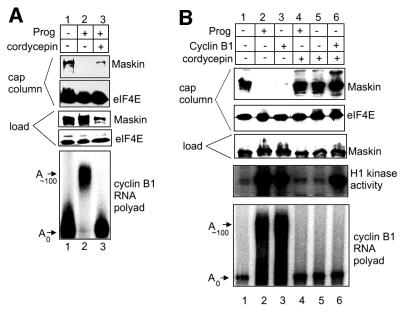Fig. 4. Maskin–eIF4E dissociation requires cytoplasmic polyadenylation. (A) Oocytes were incubated in the absence or presence of progesterone or, in some cases, with progesterone and cordycepin. When the oocytes exposed to progesterone only had matured, extracts were prepared from all the oocytes and were applied to a cap column. The relative amounts of maskin and eIF4E on the column and in the initial load solution were analyzed by a western blot. Some oocytes injected with 32P-labeled cyclin B1 3′-UTR and treated with progesterone and/or cordycepin were used to examine cytoplasmic polyadenylation. (B) Oocytes were incubated with progesterone and/or cordycepin, some of which were injected with E.coli-expressed cyclin B1 protein. Extracts were then prepared and applied to a cap column; maskin and eIF4E in the bound fractions, as well as in the load fraction, were analyzed by western blotting. The extracts were also assessed for MPF activity as determined by the phosphorylation of histone H1. Finally, some oocytes treated with the agents noted above were also injected with labeled cyclin B1 3′-UTR and examined for cytoplasmic polyadenylation.

An official website of the United States government
Here's how you know
Official websites use .gov
A
.gov website belongs to an official
government organization in the United States.
Secure .gov websites use HTTPS
A lock (
) or https:// means you've safely
connected to the .gov website. Share sensitive
information only on official, secure websites.
